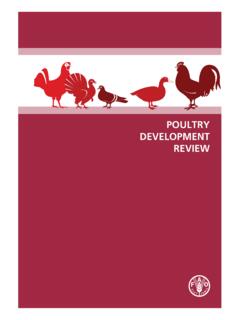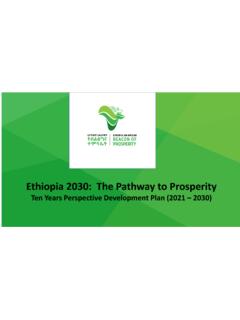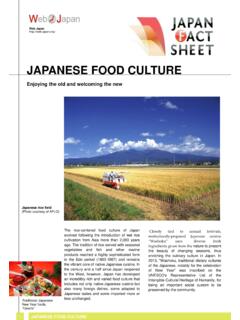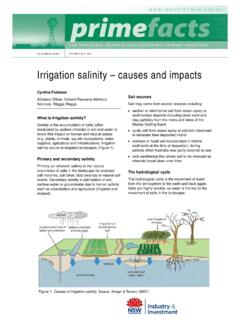Transcription of ANALYSING POLICIES TO IMPROVE AGRICULTURAL …
1 1 ANALYSING POLICIES TO IMPROVE AGRICULTURAL PRODUCTIVITY GROWTH, SUSTAINABLY Draft Framework May 2015 2 Foreword A Draft Framework for ANALYSING the role of governments in improving agriculture innovation was developed and published in OECD (2013b), AGRICULTURAL Innovation Systems: A Framework for ANALYSING the Role of the Government, OECD Publishing.. A draft Framework incorporating insights from the application of the framework to pilot country reviews and widening the scope to analyse policy areas with impacts on the productivity and sustainability of the food and AGRICULTURAL system was presented to the OECD Working Party on AGRICULTURAL POLICIES and Markets (APM) and to G20 participants in March 2014. This document contains a further revised draft Framework, which strengthen sustainability aspects, and reflects additional experience from country reviews recently published in a new series: OECD food and AGRICULTURAL review: Innovation, AGRICULTURAL productivity and sustainability.
2 This document was discussed during the May 2015 APM meeting. It will be further revised to reflect experience from additional pilot country reviews to be implemented in 2015-16. 3 DRAFT FRAMEWORK: ANALYSING POLICIES TO IMPROVE agriculture PRODUCTIVITY GROWTH, SUSTAINABLY 1. Overall assessment and recommendations 2. Overview of the food and agriculture situation 3. Economic stability and trust in institutions Macro-economic policy environment Governance and quality of public institutions 4. Investment in the food and agriculture system Regulatory environment Trade and investment policy Finance policy Tax policy 5. Capacity building and services for the food and agriculture system Infrastructure and rural development policy Labour market policy Education and skills policy 6. agriculture policy (domestic and trade related) 7. agriculture Innovation Systems (AIS) 4 ANALYSING POLICIES TO IMPROVE AGRICULTURAL PRODUCTIVITY GROWTH, SUSTAINABLY: REVISED FRAMEWORK Background 1.
3 The food and agriculture sector is subject to a wide range of economy-wide POLICIES as well as measures specific to the sector itself. This short note outlines a revised draft framework for systematically ANALYSING the full range of policy incentives and disincentives that might impact AGRICULTURAL productivity growth, sustainable use of natural assets such as land, water and biodiversity resources, and climate change. In doing so it draws on previous TAD work on AGRICULTURAL policy evaluation, AGRICULTURAL innovation and productivity, agri-environmental indicators, and green growth for It also draws heavily on policy review experiences in other economic and social policy fields, in particular those of other OECD policy communities. Further development of the Framework is expected as experience is gained in implementing it across a diversity of countries, and as additional studies provide new evidence on linkages between POLICIES , drivers and productivity and sustainability performance.
4 Overview of policy impacts 2. Figure 1 provides a schematic overview of the relationship between POLICIES and productivity and sustainability outcomes. Innovation, structural change, and access to and impact on natural resources and climate change are key drivers of productivity growth and sustainability. 3. POLICIES affect these drivers through four main channels or incentive areas: Economic stability and trust in institutions (justice, security, property rights), which are essential to attract long-term investment in the economy. Private investment, through a regulatory environment that enables competition, ensures sustainable use of resources, and facilitates the adoption of new technologies; trade that facilitate flows of goods, capital and knowledge; access to finance and tax provisions. Capacity building, including provision of essential public services, which facilitates access to markets and knowledge, and improves skills needed to innovate and IMPROVE resource use efficiency.
5 Sector-specific incentives for innovation, structural change and sustainable resource use in the food and AGRICULTURAL system from: AGRICULTURAL policy: domestic measures, including price and income support, investment support, input subsidies, risk management, adjustment and agri-environmental measures, and agriculture -specific trade measures. AGRICULTURAL innovation policy, government role in the AGRICULTURAL innovation system in providing governance, funds for innovation activities, and incentives for private investment in and adoption of innovation. 4. For each policy area, the Framework considers the likely impacts of the country's policy measures on productivity growth and sustainability, through the incentives and intended or unintended disincentives they create on the three drivers of sustainable productivity growth: innovation, structural change and sustainable use of resources and climate change (Figure 1).
6 1. See references for a list of most recent TAD reports, upon which the draft framework relies. 5 5. The relationship between innovation, economies of scale and productivity is illustrated by Figure 2, which depicts the pathways of productivity growth: technological progress reflecting early adoption of innovation by best performers; technical efficiency change representing wider diffusion of innovation; and economies of scale. Structural change also affects the capacity to adopt scale-dependent innovations. By examining these inter-relationships simultaneously, additional complexity is added to the analysis but this is necessary in order to address the complementarities and trade-offs that policy makers confront. 6. AGRICULTURAL production relies on fundamental biological processes, which combine various natural assets, or "Natural Capital",2 to other inputs (Figure 3).
7 In the Framework, sustainable productivity refers to productivity growth compatible with the preservation of natural capital in the short and long run. Like physical capital, natural capital needs investment and maintenance to retain its productive capital in the long run. To be sustainable, productivity growth will also need to account for the projected impacts of climate change, and the associated adaptation responses, and the potential role of agriculture in the global greenhouse gas mitigation effort. 7. Table 1 illustrates the implementation of the Framework using the example of investment support. The last section discusses these linkages for each policy area, and suggests a number of questions and associated indicators or sources of information that could help identify policy incentives and disincentives and assess policy outcomes. Figure 1. Policy drivers of innovation, productivity and sustainability in the agriculture and agri- food sector 2.
8 Natural capital has become the standard term to define the natural assets in their role of providing natural resource inputs and environmental services for economic production (OECD, 2015). INNOVATIONNATURAL RESOURCES AND CLIMATE CHANGESTRUCTURAL CHANGEE conomic stability and trust in institutionsMarket incentives for investmentCapacity buildingProvision of servicesSector-specificincentives Macro-economic Institutions and governance Regulations Trade and investment Finance/Credit Taxation Infrastructure Labour Education AGRICULTURAL policyPolicy areasIncentive areasDrivers of growthOutcomesProductivitySustainability AGRICULTURAL Innovation system 6 Figure 2. Pathway of productivity growth Source: OECD (2011a). Figure 3. Natural capital and multifactor productivity growth MFP: Multifactor Productivity. Source: adapted from OECD (2014a and b). Economies of scaleABff CQuantityofoutputsyQuantityofinputsxOTec hnological progressTechnical efficiency increasey/xMFP VS EAMFP: what is it changing?
9 OECD Trade and agriculture Directorate22 ProductionMFPO utputsInputsNaturalasset baseNatural resourcesPollutants, waste 7 Table 1. The example of investment support Policy area Domestic AGRICULTURAL policy Policy measure Support to farm investment Incentive area Reduces the cost of investment and thus facilitates: Drivers - Innovation the introduction of new technologies, allowing for innovation in production methods, products, marketing and organisation. - Structural change the purchase additional inputs (land, buildings), allowing for adjustment and economies of scale. - sustainable resource use and climate change the introduction of technologies for a more sustainable use of resources, if there are market and policy incentives to IMPROVE sustainable resource use Outcomes Will also depend on market and other policy incentives. Impact will be stronger if support is targeted to specific investments.
10 - Productivity Innovation and economies of scale contribute productivity growth but the extent depends on the type of innovation ( labour saving technologies may IMPROVE labour productivity but not total factor productivity) - Sustainability Some innovations can IMPROVE sustainability and climate change adaptation and mitigation. More likely to happen if support is conditional on the adoption of environmentally, climate friendly technologies and practices. Next steps 8. Future work will draw upon a range of expertise both within and outside OECD and will follow two broad pathways: additional pilot country reviews and further analytical work intended to strengthen both the conceptual base of the Framework and its analytical capacity. 9. In addition to drawing further lessons from experiences with pilot country reviews in Australia, Brazil, Canada, and most recently the Netherlands, new pilot country reviews have been launched with Turkey and are planned for the United States and, possibly, China.

















